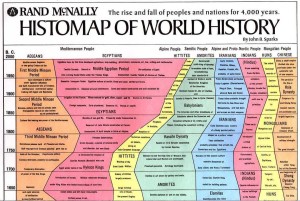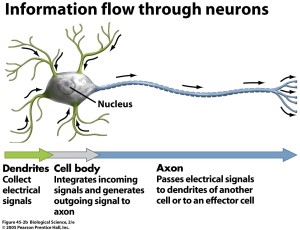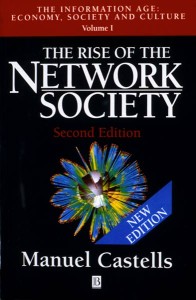Several times while reading Castells, I thought of science fiction and the philosophical musings about time, space, dimensions, and what not. So imagine my surprise when I read Castell use the phrase, “city on the edge.” His references to time and space as abstractions made the next jump inevitable: one of Star Trek’s most feted episodes, outlined here. For those of you unfamiliar with the series, time isn’t tied to space and permanency at all. Perfect fit for Castells.
Chapters 2 & 3: Castells’ early chapters lay the historical groundwork for these next sections, establishing as he does his argument that we are a part of a global (not planetary) information revolution on or above the same level of significance as the Industrial Revolution. (See this Wall Street Journal article for some interesting connections.)
Instead of the manufacturing industry, however, the new revolution is based on communication technology. His book describes this new network in terms of nodes and links, diffusions and systems – with transformations and innovations occurring where ideas are exchanged, usually at nodes that “interact with economy and society” (62-69). This new economy, however, is not one of power in terms of energy production but “informational” in terms of mass communication and the “new culture” it creates (77, xxx). Interestingly, he argues that the infrastructure itself is not at the heart of this phenomenon – it is the communication itself (xxxvii). This is the economy of chained networks and nodes he describes as being the components of this network society – what seems remarkably like an ecology.
Connections to Ecosystems and Neurobiology: In his early chapters, he outlines key agency nodes that are the basis of this society: information, pervasiveness, networking logic, flexibility, and convergence (69-71). The product of this new economy is not goods and services, however; it is “information” (78). Therefore, could it be he is describing not just an economy of knowledge, but an ecosystem of knowledge with information as its key medium for growth? Thinking back to the neurobiology readings, the chemical-based electrical impulses that constitute information and the neuronal system they travel could be considered a medium. Like Castells’ description of the economic system of his new society, these information corporations form strategic alliances very much like Spinuzzi’s chained activity networks comprised of nodes (each one an alliance). This system evolves and diffuses along what Castells calls a “global web” (122) – growing in ways that sound remarkably like neural pathways, networks within networks (131). I found his description of diffusion rather interesting, extending knowledge from major concentrations of states / businesses typically characterized as dominant economic / power centers (nodes again), but “skewed toward and defined by advanced cultures” (126). His explanation of this seems to replay a long history of the ways in which economies and their “affordances” favor the strong and the rich — discrimination that is based on value systems, but in this economy, it’s information and communication that are the valued coins of a global system built on local nodes (134). It is the technology itself, Castells asserts, that changes how the market establishes that value (156), citing the growth and confluence of tech-influenced infrastructures composed of financial markets, software companies, companies like Yahoo that facilitate communication, and companies like Amazon that create a new market base of strictly online commerce (148-153).
So, key concepts for Chapter 2 might be summed up in these two quotations:
- “The new economy brings information technology and the technology of information together in the creation of value out of our belief in the value we create” (160-162).
- The “[e]ssential component of the new economy: networking. The organizational transformation of the economy, as well as … society … are … a necessary condition for institutional restructuring and technical innovation” (160).
 In Chapter 3, Castells discussed a history of trends in the emergence of this new culture. He goes to great lengths to be sure we as readers understand that by culture, he does not mean “a set of values and beliefs linked to a particular society” (163). Rather, he grounds his definition of the term in the idea of “ideational bases for institutionalized authority relations” or “organizational logics” (164) – a concept that again seems highly similar to our exploration of intersecting ecologies (Guatteri, I believe). In this chapter, he takes us through the evolution of “the large corporation,” moving through Fordism (166) to the new management he calls “Toyotism” (169). From Taylorism / Fordism to this new era of management and corporate systemization, he points to the evolution of what he calls a “horizontal corporation” (176) that is in essence “an articulated network of multifunctional decision-making centers” (178). Networks like the Cisco Systems are the new archetype that has emerged to replace the former (Fordism) with a “business model of the Internet-based economy…a global networked business model” (180). Like Bateson, Castells notes that the importance of the mind or “mentality” – not the tools or the computer-based infrastructure –is the driving force of this evolution (185). However, Castells also notes that without the computer, none of this would have been possible (185). Yin and yang.
In Chapter 3, Castells discussed a history of trends in the emergence of this new culture. He goes to great lengths to be sure we as readers understand that by culture, he does not mean “a set of values and beliefs linked to a particular society” (163). Rather, he grounds his definition of the term in the idea of “ideational bases for institutionalized authority relations” or “organizational logics” (164) – a concept that again seems highly similar to our exploration of intersecting ecologies (Guatteri, I believe). In this chapter, he takes us through the evolution of “the large corporation,” moving through Fordism (166) to the new management he calls “Toyotism” (169). From Taylorism / Fordism to this new era of management and corporate systemization, he points to the evolution of what he calls a “horizontal corporation” (176) that is in essence “an articulated network of multifunctional decision-making centers” (178). Networks like the Cisco Systems are the new archetype that has emerged to replace the former (Fordism) with a “business model of the Internet-based economy…a global networked business model” (180). Like Bateson, Castells notes that the importance of the mind or “mentality” – not the tools or the computer-based infrastructure –is the driving force of this evolution (185). However, Castells also notes that without the computer, none of this would have been possible (185). Yin and yang.
He coins the phrase “spirit of informationalism” as a characteristic of this new networked society and, while rather interesting, it seemed as though it was Castells’ effort to avoid the traditional conceptual frame of the term “culture” in this discussion. He seems to want this term of “culture” to exist in multiple dimensions – which at times makes it a bit confusing, as though he wants it both ways – but settles on a definition of this defining “spirit” as “the culture of ‘creative destruction’ (215). Perhaps this is an inevitable dilemma of any discussion of this sort of networked ecosystem based on knowledge / information / communications – we are exploring a system that employs both the philosophical as well as the physical. Some ephemerality is to be expected, I suppose. (Just so long as we don’t need to follow Bateson’s use of LSD to be fully versed in the proposal.)
Chapters 5-7: With the basic definitional concepts behind him, Castells moves into a discussion of the “culture of virtuality” in Chapter 5, beginning with a brief discussion of language and communities. This chapter reminds me of the Amanda Case TED talk, “We Are All Cyborgs Now” (see video below) in which her explanation of communication technologies (ironically sponsored by Cisco) allowing us to fold space seems to offer an example of Castells’ “space of flows” and “timeless time.” He walks us through the influence of Marshall McLuhan in the 1960s on the “diffusion of television” creating “a new galaxy of communication” (358) and an environment of communication (362). Reviewing the criticisms of television as a communications media, Castells points out that while the system may be one-way, the communication process still allows for “each culture and social group” to form “a specific relationship to the media system, such as might happen if surfing channels is understood as a way the audience “create[s] its own visual mosaic” (370). This chapter explores the formative pressures created by government, business, and social policies / politics have influenced the emergence of communication systems beyond (diffused from) the television set that have contributed to the “notion[s] of mass culture” permeating this discussion (359). He asserts that references to this “mass media” system is actually incorrectly framed as a “form of culture”; it is more accurate to refer to it as a “technological system” instead (364). There was simply SO much packed into this chapter that I find myself forced to gloss over the depths to resort to summarizing it from the shoreline: he begins with culture and language, and he concludes the chapter with the observation that our new systems of communication blur the boundaries between virtuality and reality so much (he refers the the Dan Quayle-Murphy Brown episode as proof) that it creates a “new text of the real and the imaginary” (405). This creates the potential to “embrace and integrate all forms of expression” as well as “radically transform space and time” in its creation of “a new culture” (406). As students of new media, this observation should either excite or frighten us to no end.
Link to my Object of Study: This chapter’s observations led me to wonder whether MOOCs behave similarly to how Castells describes the television interactivity conundrum. I wondered if this isn’t an illusion, however, when proponents of MOOCs assert that the virtual space allows students to be co-creators of their learning and the learning space. But how much co-creation is possible if the spatial design must conform first to the educational system that funds its existence and awards credence by framing it in the system of milestones / assessment practices expected of an institution of higher education? Knowledge diffusion may be less prescribed, but the structural system would still dictate some degree of potential pathway order. In fact, Castells remarks that the “[s]patial inequality in Internet access” cited in many MOOC criticisms “is one of the most striking paradoxes of the Information age, given the supposedly placeless characteristic of the technology” (377). Yet it seems this may be countered by what Castells refers to as the system’s potential for “innovation, flexibility, and decentralization,” which then “translate into new patterns of communications” (385-86).
Chapters 6 and 7 move down a more theoretical, even metaphysical, pathway as he introduces two concepts: the space of flows and timeless time. These two chapters were especially challenging, as I’m clearly all about pragmatic application of theory. (This is where my reference to the Amanda Case TED talk came in handy, as a way to provide a touchstone reference.) The concept of space / flowing reminds me of the neuron pathways and “channels” described in last week’s readings, but it also seems to echo the theories of Activity and even Actor Network, where the movement and agency highlight both the limits and the permeability of boundaries (a form of space). One of the more interesting observations in this chapter was his assertion that “space is the expression of society” (440). It is as if he sees space much like we might see boundaries and pathways – but acknowledging that the “map is not the territory” (Bateson’s reference to Korzybski on page 455). This would seem to substantiate Castells’ comment that “[s]patial forms and processes are formed by the dynamics of the overall social structure.” A bit frightening is his observation that the “background of meaning” informing this space is no longer cultural “experience, history, and specific culture,” but is being replaced instead by “dominant interests” (450). To avoid this, Castells champions the concept of “nude architecture,” or his “space of flows” (450). But how can any type of architecture be totally devoid of influence or neutral? Even the hypothesis itself places a preferred value on this new culture and network system, lauding its benefits while also pointing out its dangers. This is a point in the book where I think the author extends his toe just a bit too far over the line.
In sum, his “space of flows” appears to be – like our neuron studies – a metaphor meant to replace pre-existing models or interpretive lenses with something more nuanced, more suited to the space/non-space that is our concept of the vast web structure of the Internet…a structure that can only be conceptualized if we include the non-forms like space, movement, ideas. And because our concept of space is grounded in not-space (i.e., the nodes of the material world), the same must be true of time. Humans are creatures dependent on the concrete – we tie ourselves to timelines and structures so we have a sense of place and identity. Castells argues that “linear, irreversible, measurable, predictable time is being shattered in the network society” (463), and we therefore need a new form – his “timeless time” – to take its place. He defines these two concepts as linked, and much like Case refers to the “folding of space” through a communication technology, one shapes the other…and in turn both shape / characterize this new “network society” (499).
Castells’ philosophy of society and technology is compelling, yet I wonder if it can really be a replacement or even an evolution if it can only be grounded through negation of existing frameworks of human activity and concrete concepts such as place / space. Thinking back to CHAT and the call to revisit the canons of our culture, I am reminded of Ecclesiastes: “There is nothing new under the sun” (Ecclesiastes 1:9) if one of the primary hubs of new systems remains the human being at the center of it all…the one who has the agency to step back and forth through portals christened “The Guardian of Forever.”
Works Cited:
Bateson, Gregory. Steps to an Ecology of Mind. New Jersey: Jason Aronson Inc., 1987.
Case, Amanda. “We Are All Cyborgs Now.” 11 Jan. 2011. TED.com
Castells, Manuel. Rise of the Network Society. 2nd ed. Malden, MA: Wiley-Blackwell, 2010.
“City on the Edge of Forever.” Star Trek. NBC. 6 April 1967. Television.
“Unit 10: Neurobiology.” Rediscovering Biology. Annenberg Foundation. 2013. Web.






